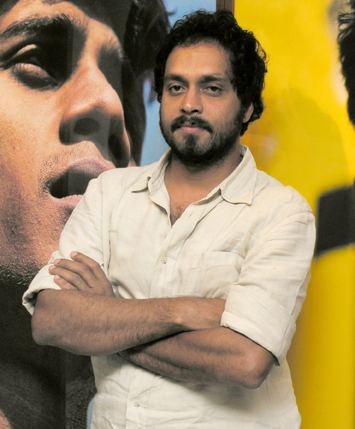|

Born
in 1971, Riyas Komu graduated with Painting as his specialization and
has since than extended himself to sculpture, photography and video
installations. He is also a recipient of K.K. Hebbar Foundation
Scholarship and Bombay Art Society Award, 1996 and Maharashtra State Art
Prize 1995. Komu was a participant in the 52nd Venice Biennale 2007
curated by Robert Storr. His other prominent museum shows include
Paris-Delhi-Bombay, Centre
Pompidou, Paris; Crossroads India Escalate at Prague Biennale 5.
Other prominent museum shows include
Concurrent India, Helsinki Art Museum Tennis Palace, Finland;
Indian Highway, Museum of
contemporary Art, Lyon; Herning
Kunstmuseum, Herning, Denmark;
India Awakens: Under the Banyan Tree, Essl Museum, Austria;
Finding India, Art for the New Century, Museum of Contemporary Art;
Milan Museum show, curated by Daniella Polizolli and
India Contemporary, GEM, Museum of
Contemporary Art, Hague; India Now: Contemporary Indian Art Between
Continuity and Transformation, Provincia di Milano, Milan, Italy,
India Xianzai: Contemporary Indian Art, Museum of Contemporary Art (MOCA),
Shanghai; Modern India, organized by Institut Valencià d'Art
Modern (IVAM) and Casa Asia, in collaboration with the Ministry of
Culture at Valencia, Spain. His recent solo shows include Oil's Well,
Let's Play!, Fondazione Arnaldo Pomodoro, Milan; Subrato to Cesar,
Gallery Maskara, Mumbai in association with The Guild Art Gallery,
Mumbai and Safe to Light, Azad Art Gallery, Tehran.
Riyas Komu says that his work draws from the public domain. His subjects
are charged with significance bringing about a disturbance depicting an
element of political disquiet. For Riyas, art is a medium for social
comment on the situations the world is facing today.” Komu deploys
portraiture, also, to register a cryptic side or oblique remark on
contemporary culture. Riyas Komu’s recent paintings and sculptures
propose a bold re-formatting of the genre of portraiture. Komu’s
portraits are close-up shots of nameless and dispossessed individuals
redeemed, visually if not materially, from the flux of life at the
margins of globalization” – Ranjit Hoskote.
“Riyas Komu’s recent paintings and sculptures propose a bold
re-formatting of the genre of portraiture. Komu’s portraits are close-up
shots of nameless and dispossessed individuals redeemed, visually if not
materially, from the flux of life at the margins of globalization. These
are faces of people captured in the attitude of waiting, of foreboding
or memorializing: these are faces of witnesses, who depose before us,
silently obliging us to acknowledge the genocides and mass migrations,
the famines and desolations of our catastrophic epoch. Komu deploys
portraiture, also, to register a cryptic side or oblique remark on
contemporary culture. He does not not permit us direct and easy access
to his subjects: in his handling, the portrait become a fateful
reminder: we see the Other as framed by the televisual eye, for Komu’s
figures are often marked as though with masking tape or black
identity-protection bands or partially concealed by lattices. Signs of
immunity from recognition, these semiotic interpolations double as
threats of de-personalization: the rawness of the human predicament is
sometimes camouflaged by these refinements, whoch convey both security
and constraint in relation to Komu’s figures”. – Ranjit Hoskote
He
paints pictures based on photographic references from the print and
television media. His subjects are charged with significance bringing
about a disturbance depicting an element of political disquiet. For
Riyas Komu, art is a medium for social comment on the situations the
world is facing today. His canvas has youthful and the immersion in
urban iconography is perhaps most evident in his works. What is
remarkable about the paintings of Riyas are the multiple media he uses.
The works in oil are thick and over-layered, and this gives them more
dimension and life. The figures and the backdrop spring out and hit you
and there is no escaping from what first appears stark and simple and
seem to get more and more complex as it grows on you. About his video:
He has a passion for making documentary films. The one he worked on a
couple of years back had an unusual theme –“The politics of nostalgia
and food.” A video movie of eight minutes, it was shot on the streets
and roadside restaurants of Mumbai. “The documentaries I make are an
extension of my feelings and views, and they have similar themes,
toughing life’s many facets”, says Riyas.
His
recent solo ‘Mark Him’ was held at The Guild, it mainly consisted of
photographs. About these works Riyas says, “I have not known a greater
joy than that of watching guys in shorts kicking a ball around. I have
done the feetie myself a number of times. But there has always
been a gnawing feeling in the back of my head that kept on saying: the
best of goals are not always 'the best of goals'. So I set one for
myself — to use art to redeem the place of our footballers in the
society, in our history. Therefore, MARK HIM”. |
|
|
|